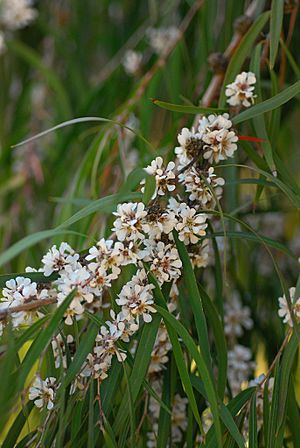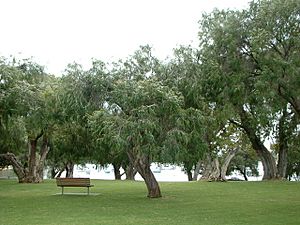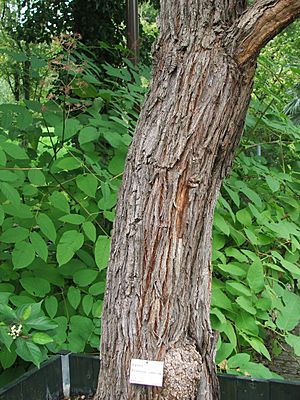Agonis flexuosa facts for kids
Quick facts for kids Agonis flexuosa |
|
|---|---|
 |
|
| Flowers of A. flexuosa | |
| Scientific classification | |
| Genus: |
Agonis
|
| Species: |
flexuosa
|

Agonis flexuosa is a type of tree that grows in the south west part of Western Australia. It is the most common Agonis species. This tree is easy to spot and is often seen in parks and along roads in Perth.
People often call this tree the Western Australian peppermint, Swan River peppermint, or just peppermint. It's also known as willow myrtle because its branches hang down like a willow tree.
The Noongar people, who are the traditional owners of the land, have their own names for this tree. They call it Wanil, Wonnow, Wonong, or Wannang.
Contents
What it Looks Like
A. flexuosa is usually a small, strong tree. It typically grows less than 10 meters (about 33 feet) tall. Sometimes, it can reach up to 15 meters (about 49 feet).
It has brown bark that feels a bit rough. Its leaves are long, narrow, and a dull green color. The tree produces small white flowers that grow in tight bunches. These flowers appear between August and December.
This tree has a "weeping" shape, meaning its branches droop downwards. From a distance, it looks a lot like a weeping willow. Its narrow leaves can grow up to 150mm (about 6 inches) long. You can easily identify it by the strong smell of peppermint that comes out when you crush or tear its leaves.
After flowering, the tree produces a hard, round fruit. This fruit is about 3 to 4 millimeters (0.12 to 0.16 inches) wide. It has three parts that open up to release many tiny seeds.
How it Got its Name
The name Agonis comes from a Greek word, agon. This word means "a cluster," which describes how the fruits grow together. The species name flexuosa is a Latin word. It means "full of bends." This refers to how the tree's stem zig-zags, changing direction at each leaf.
This tree was first placed in a different group of plants in 1819. But in 1844, it was moved into the Agonis group.
There are two main types, or varieties, of Agonis flexuosa:
- Agonis flexuosa var. flexuosa: This type is very common. It is found in coastal areas of Southwest Australia.
- Agonis flexuosa var. latifolia: This type grows in a smaller area. It is found west of Walpole to Cheyne Beach and also in the Stirling Range.
Some special versions of the tree have been grown for gardens. These might be smaller shrubs or trees that don't flower much. Some popular garden types include Agonis ‘Belbra Gold’ and Agonis ‘Fairy Foliage’. A very common small version is Agonis 'Nana'. It is often used as a hedge in Perth.
Where it Grows
Agonis flexuosa grows in a strip of land near the coast. This area stretches from just north of Perth. It goes south through the Swan Coastal Plain. Then it continues along the coast to areas east of Bremer Bay.
You can find these trees in places with limestone, sand dunes, and sandy soils. They usually grow a bit inland from the beach. They also grow as smaller plants under taller trees in Tuart forests.
Growing Agonis flexuosa
This tree is often planted in large groups, like along streets. It has also been introduced to Rottnest and Garden Islands, which are close to its natural home. Agonis flexuosa is a nice tree for gardens in places with mild weather.
However, if you have a small yard, you need to be careful. This tree grows quickly. It can drop a lot of leaves and branches. Its main trunk can also become very wide compared to the rest of the tree.
Not many other plants grow well under Agonis flexuosa trees. This is because the fallen leaves can stop other plants from growing.
Both the main Agonis flexuosa tree and the 'Nana' variety respond well to trimming. People often cut them back to the main trunk. This helps new growth appear and keeps the tree's top part thick and neat. If not trimmed, the tree's top can become thin.
Sometimes, especially on rocky ground, these trees can grow large roots that stick out. But this is rare in flat, sandy areas. Older Agonis flexuosa trees can also have a twisted or spiral pattern in their bark. This pattern becomes more noticeable as the tree gets older.
Uses of the Tree
The Noongar people used the leaves of the peppermint tree as an antiseptic. This means they used it to clean wounds and prevent infections. They also used the trunks of young trees to make spear shafts and digging sticks.
See also
 In Spanish: Menta de Australia Occidental para niños
In Spanish: Menta de Australia Occidental para niños


